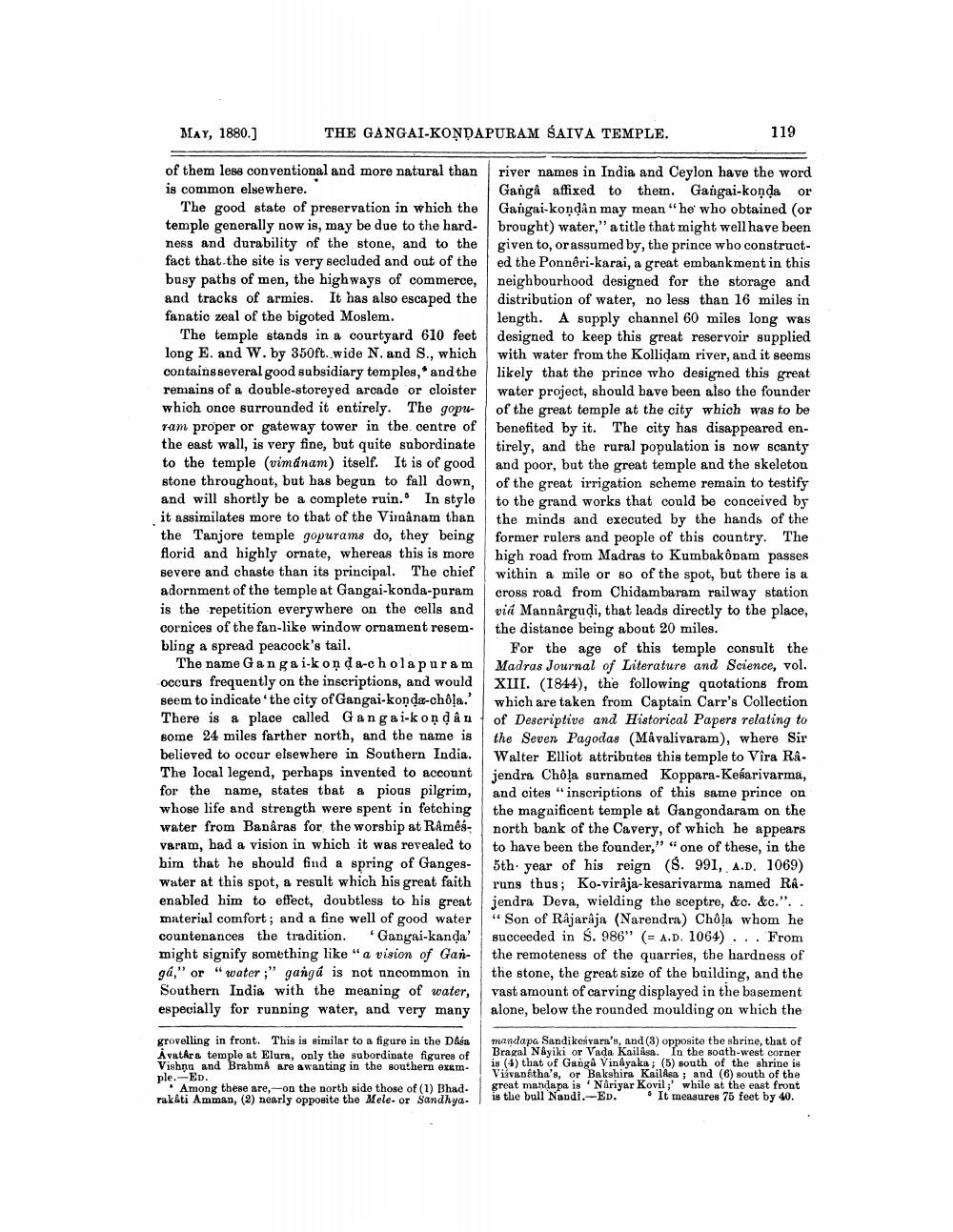________________
MAY, 1880.)
THE GANGAI-KONDAPURAM SAIVA TEMPLE.
119
of them less conventional and more natural than is common elsewhere.
The good state of preservation in which the temple generally now is, may be due to the hardness and durability of the stone, and to the fact that the site is very secluded and out of the busy paths of men, the highways of commerce, and tracks of armies. It has also escaped the fanatic zeal of the bigoted Moslem.
The temple stands in a courtyard 610 feet long E. and W. by 350ft. wide N. and S., which contains several good subsidiary temples, and the remains of a double-storeyed arcade or cloister which once surrounded it entirely. The gopuram proper or gateway tower in the centre of the east wall, is very fine, but quite subordinate to the temple (vimanam) itself. It is of good stone throughout, but has begun to fall down, and will shortly be a complete ruin. In style it assimilates more to that of the Virgânam than the Tanjore temple gopurams do, they being florid and highly ornate, whereas this is more severe and chaste than its principal. The chief adornment of the temple at Gangai-konda-puram is the repetition everywhere on the cells and cornices of the fan-like window ornament resem. bling a spread peacock's tail.
The name Gangai-kond a-cholapuram occurs frequently on the inscriptions, and would seem to indicate the city of Gangai-konda-chô!a. There is a place called Gangai-kondân some 24 miles farther north, and the name is believed to occur elsewhere in Southern India. The local legend, perhaps invented to account for the name, states that a pious pilgrim, whose life and strength were spent in fetching water from Banaras for the worship at Råmés. varam, had a vision in which it was revealed to him that he should find a spring of Gangeswater at this spot, a result which his great faith enabled him to effect, doubtless to his great material comfort; and a fine well of good water countenances the tradition. Gangai-kanda' might signify something like "a vision of Ganga," or "water;" ganga is not uncommon in Southern India with the meaning of water, especially for running water, and very many
river names in India and Ceylon have the word Gangå affixed to them. Gangai-konda or Gangai-kondan may mean "he' who obtained (or brought) water," a title that might well have been given to, or assumed by, the prince who constructed the Ponnêri-karai, a great embankment in this neighbourhood designed for the storage and distribution of water, no less than 16 miles in length. A supply channel 60 miles long was designed to keep this great reservoir supplied with water from the Kollidam river, and it seems likely that the prince who designed this great water project, should bave been also the founder of the great temple at the city which was to be benefited by it. The city has disappeared entirely, and the rural population is now scanty and poor, but the great temple and the skeleton of the great irrigation scheme remain to testify to the grand works that could be conceived by the minds and executed by the hands of the former rulers and people of this country. The high road from Madras to Kumbakonam passes within a mile or so of the spot, but there is a cross road from Chidambaram railway station vid Mannârgudi, that leads directly to the place, the distance being about 20 miles.
For the age of this temple consult the Madras Journal of Literature and Science, vol. XIII. (1844), the following quotations from which are taken from Captain Carr's Collection of Descriptive and Historical Papers relating to the Seven Pagodas (Mávalivaram), where Sir Walter Elliot attributes this temple to Vîra Rê. jendra Chola surnamed Koppara-Kesarivarma, and cites "inscriptions of this same prince on the magnificent temple at Gangondaram on the north bank of the Cavery, of which he appears to have been the founder," "one of these, in the 5th year of his reign ($. 991, A.D. 1069) runs thus; Ko-virâja-kesarivarma named RAjendra Deva, wielding the sceptre, &c. &c.".. “Son of Rajaraja (Narendra) Chôļa whom he succeeded in $. 986" (= A.D. 1064) . . . From the remoteness of the quarries, the hardness of the stone, the great size of the building, and the vast amount of carving displayed in the basement alone, below the rounded moulding on which the
grovelling in front. This is similar to a figure in the Disa Avatara temple at Elurn, only the subordinate figures of Vishna and BrahmA are awanting in the southern exemple. ED.
Among these are,--on the north side those of (1) Bhad. rak&ti Amman, (2) nearly opposite the Mele- or Sandhya.
mandapa Sandikeávara's, and (3) opposite the shrine, that of Bragal N&yiki or Vada Kailasa. In the south-west corner is (4) that of Ganga Vinayaka; (5) south of the shrine is Vivanetha's, or Bakshira Kailasa ; and (6) south of the great mandapa is Näriyar Kovil;' while at the east front is the bull Nandi.ED. It measures 75 foet by 40.




